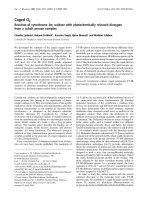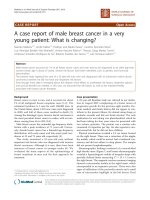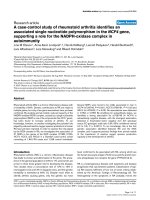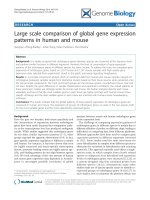Báo cáo y học: "A female survivor of childhood medulloblastoma presenting with growth-hormone-induced edema and inflammatory lesions: a case report" doc
Bạn đang xem bản rút gọn của tài liệu. Xem và tải ngay bản đầy đủ của tài liệu tại đây (931.44 KB, 5 trang )
BioMed Central
Page 1 of 5
(page number not for citation purposes)
Journal of Medical Case Reports
Open Access
Case report
A female survivor of childhood medulloblastoma presenting with
growth-hormone-induced edema and inflammatory lesions: a case
report
Veronica Biassoni*
1
, Federica Pallotti
2
, Filippo Spreafico
1
, Ettore Seregni
2
,
Lorenza Gandola
3
, Antonella Martinetti
2
, Emilio Bombardieri
2
and
Maura Massimino
1
Address:
1
Department of Pediatric Oncology, Fondazione IRCCS Istituto Nazionale per lo Studio e la Cura dei Tumori, Via Venezian 1, 20133
Milan, Italy,
2
Department of Nuclear Medicine, Fondazione IRCCS Istituto Nazionale per lo Studio e la Cura dei Tumori, Via Venezian 1, 20133
Milan, Italy and
3
Department of Radiotherapy, Fondazione IRCCS Istituto Nazionale per lo Studio e la Cura dei Tumori, Via Venezian 1, 20133
Milan, Italy
Email: Veronica Biassoni* - ; Federica Pallotti - ;
Filippo Spreafico - ; Ettore Seregni - ;
Lorenza Gandola - ; Antonella Martinetti - ;
Emilio Bombardieri - ; Maura Massimino -
* Corresponding author
Abstract
Introduction: The improved survival of children with brain tumors has increased concerns about
treatment-related sequelae. Growth hormone deficiency is frequently observed after craniospinal
irradiation for medulloblastoma. It has been widely reported that growth hormone replacement
therapy does not increase the risk of second tumors, but there are reports in the literature of
growth hormone, and its downstream mediator insulin-like Growth Factor 1, having an important
proinflammatory action. There are few reports, however, on the "in-vivo" induction of edema and
symptomatic inflammatory lesions during replacement therapy.
Case presentation: We report the case of a 7-year-old girl treated for metastatic
medulloblastoma who developed growth hormone deficiency 2 years after oncological treatment.
Three months after replacement therapy, magnetic resonance imaging showed exacerbation of her
brain edema, which was already present after oncological treatment. We consequently suspended
the growth hormone until a new magnetic resonance image obtained 3 months later documented
a reduction of the inflammatory areas. We then re-introduced somatotropin at lower doses with
no further increase in brain edema in subsequent radiological controls.
Conclusion: This case and its iconography suggest a strong association between growth hormone
administration and the exacerbation of inflammatory reactions within the tumor bed. Replacement
therapy should be carefully monitored in this particular subset of patients.
Published: 16 January 2009
Journal of Medical Case Reports 2009, 3:17 doi:10.1186/1752-1947-3-17
Received: 21 January 2008
Accepted: 16 January 2009
This article is available from: />© 2009 Biassoni et al; licensee BioMed Central Ltd.
This is an Open Access article distributed under the terms of the Creative Commons Attribution License ( />),
which permits unrestricted use, distribution, and reproduction in any medium, provided the original work is properly cited.
Journal of Medical Case Reports 2009, 3:17 />Page 2 of 5
(page number not for citation purposes)
Introduction
Survival rates for patients with malignant pediatric brain
tumors have remarkably improved in recent years; the 5-
year relative survival probability for all brain malignancies
combined being approximately 69%, depending on the
pathophysiologic and morphologic characteristics for
children diagnosed in 1992 or later [1].
Due to this improvement, more attention is being focused
on the possible sequelae of oncological treatments (sur-
gery, chemotherapy and radiotherapy), among which
endocrinopathies are most frequently observed in
patients treated for central nervous system (CNS) tumors
with growth-hormone deficit (GHD) which is often
observed after irradiation. In particular, craniospinal irra-
diation for medulloblastoma commonly leads to GHD
(67% at 10 years after cranial irradiation greater than 24
Gy, 80% when greater than 30 Gy) and primary or mixed
hypothyroidism. In fact, irradiation of the hypothalamic-
pituitary axis causes a characteristic pattern of hormone
loss: growth hormone (GH) is usually the first to be
affected, followed by the gonadotrophins, ACTH and
TSH.
In the past, there was much concern about whether GH
therapy might increase cancer risk, but it has now been
established that GH treatment does not increase the rate
of tumor recurrence in patients previously treated for pri-
mary CNS lesions [2,3], and recent guidelines recom-
mend starting GH therapy a year after the end of the
oncological treatment if there is no evidence for further
tumor growth.
In addition to the oncological safety of GH, there are
reports that GH and its downstream mediator, insulin-
like Growth Factor 1 (IGF-1), have an important proin-
flammatory action [4-8]. A recent study by Pagani et al.
emphasizes that the production of proinflammatory
cytokines by the peripheral blood mononuclear cells is
lower in GH-deficient children than in healthy, age-
matched individuals, and that cytokine production is sig-
nificantly increased after 3 months of GH therapy [4].
Another study on the relationship between GH and brain
edema in rat brain freeze-injury models [5] revealed that
GH crosses the blood-brain barrier, finding a considerable
amount of GH receptors whose density is higher in the
choroid plexus, hypothalamus, hippocampus, pituitary
region, and spinal cord [6]. Moreover, GH administration
affects the concentrations of several neurotransmitters in
the cerebrospinal fluid and is probably related to post-
injury edema [6]. Further interactions between GH and/or
IGF-1 with the immune-inflammatory system have been
documented in the literature. For example, both GH and
IGF-1 increase the bactericidal capacity of human poly-
morphonuclear neutrophils via intracellular reactive oxy-
gen intermediaries, as well as increasing their
complement receptor expression [7]. Moreover, GH has a
proinflammatory activity also modulating several vascular
growth factors; IGF-1 correlates with angiogenin levels in
particular, stimulating endothelial cell proliferation as
well as collagen synthesis, fibroblasts, and vascular
smooth muscle cells [8].
GH replacement therapy in patients previously treated for
CNS tumors is subject not only to oncological assess-
ments, but also to auxological and endocrinological
parameters (growth failure, IGF-1 levels, pituitary defi-
ciencies, skeletal growth), and to the results of arginine
and/or clonidine challenges.
Case presentation
We report the case of a 7-year-old girl with metastatic
medulloblastoma (T3b M1 according to the Chang stag-
ing system) diagnosed as a result of an epileptic seizure
after 3 months of headache. Brain MRI in July 2000
revealed a mass in the posterior fossa, in the midline cer-
ebellum next to the fourth ventricle and vermis, causing
hydrocephalus and an initial herniation of the cerebellar
tonsils. At the end of July, she underwent a macroscopi-
cally complete resection of a 3 × 3 cm nodule filling the
fourth ventricle and attached to its lateral recesses. The
final histologic diagnosis was classic medulloblastoma.
A postoperative cerebral and spinal MRI in August 2000
revealed an ambiguous neoplastic residue close to the sur-
gical cavity, jutting out into the fourth ventricle, and
malignant neoplastic cells were found in the cerebrospi-
nal fluid.
From August 2000 to March 2001, the girl was treated
according to our institutional protocol for metastatic
medulloblastoma/PNET in children over 3 years of age,
which included sequential high-dose chemotherapy, radi-
otherapy, and myeloblative-dose chemotherapy with
autologous hemopoietic stem cell rescue [9]. The protocol
was partially modified omitting two scheduled vincristine
administrations due to intestinal toxicity after the first
course.
Hyperfractionated accelerated radiotherapy was adminis-
tered from November to December 2000, scheduled in
two daily 1.3 Gy fractions 6 hours apart, 5 days a week for
a total dose of 31.2 Gy to the craniospinal axis plus a
boost to the posterior fossa using a 1.5 Gy fractionation
twice a day to give a total dose of 59.7 Gy.
Diagnostic lumbar puncture before radiotherapy still doc-
umented malignant neoplastic cells, while lumbar punc-
ture and MRI after radiotherapy and between the two
Journal of Medical Case Reports 2009, 3:17 />Page 3 of 5
(page number not for citation purposes)
myeloablative courses were both negative, with the latter
showing only surgical sequelae.
In June 2001, our patient started the follow-up program
with routine MRI and outpatient visits. In September
2001, MRI showed multiple focal contrast-enhanced areas
in the right thalamus, brainstem, and cerebellum, inter-
preted as iatrogenic alterations. A spectrum MRI con-
firmed their necrotic and treatment-related nature. These
lesions had increased in number in the MRI of December
2001, and they appeared more strongly gadolinium-
enhanced in subsequent images in February and April
2002. Cortisone therapy was administered from January
2002, starting with 6 mg/day. It was then progressively
tapered off, but the neurological signs became worse, with
cervical pain and frontal headache, so it was re-introduced
from March to July 2002.
In March 2002, a year after ending the oncological treat-
ment, an endocrinologist assessed the girl. At 8 years and
4 months old, her growth characteristics were: height 119
cm (3
rd
percentile), growth target 160 cm (25
th
percen-
tile), growth rate 0 cm per year, and basal IGF-1 below the
3
rd
percentile. Since her growth had not recovered, GH
replacement therapy was started after an arginine chal-
lenge in February 2004, administering somatotropin at a
dosage of 5 mg per week (15 UI, 0.16 mg/Kg per week).
In May 2004 (3 months after starting somatotropin), MRI
showed a clear progression of the enhanced lesions dis-
tributed along the occipital horn of the right lateral ventri-
cle and the peritrigonal region. The main finding was
perifocal edema, already seen at previous follow-up scans
but now extending further, to the posterior half of the
right hemisphere and in contact with the basal nuclei and
the thalamus. There was no evidence of recurrent disease
in the posterior fossa. The girl also reported headache and
visual impairment.
Relationship between somatotropin administration, MRI, clinical outcome, and steroid administrationFigure 1
Relationship between somatotropin administration, MRI, clinical outcome, and steroid administration. Growth
hormone administration was related to both MRI changes and a worse clinical performance. Dexamethasone administration
produced no amelioration, either clinical or visible in the MRI. This was achieved instead by first suspending somatotropin, then
restoring it at lower doses.
GH REPLACEMENT
THERAPY
Somatotropin
0.16 mg/Kg a week
DEXAMETHASONE
ADMINISTRATION
FEBRUARY
2004
MAY
2004
JUNE
2004
STOP
GH REPLACEMENT
THERAPY
MARCH
2005
GH REPLACEMENT
THERAPY
Somatotropin
0.09 mg/Kg a week
MRI: INCREASE OF PERIFOCAL
EDEMA OCCUPYING THE
POSTERIOR HALF OF THE RIGHT
HEMISPHERE AND IN CONTACT
WITH THE BASAL NUCLEI AND
THALAMUS
MRI: REDUCTION IN
INFLAMMATORY AREAS
IN BOTH THE SUPRA-
TENTORIAL AREA AND
THE POSTERIOR FOSSA
MRI: NO
FURTHER
INFLAMMATO
RY LESIONS
NO
CLINICAL
AMELIORATION
VISUAL IMAPIRMENT, HEADACHE CLINICAL AMELIORATION
Journal of Medical Case Reports 2009, 3:17 />Page 4 of 5
(page number not for citation purposes)
Cortisone therapy was administered again, with no
improvement in the visual impairment or MRI findings.
Due to the latter, and the possible proinflammatory activ-
ity of GH, somatotropin was discontinued in June 2004.
Subsequent MRIs in September 2004 (3 months after sus-
pending somatotropin) and January 2005 (after 7 months
without somatotropin) showed a remarkable reduction of
the inflammatory areas both in the supratentorial region
and in the posterior fossa; the visual impairment had also
improved after suspending GH. In March 2005, we intro-
duced somatotropin again at lower doses (3 mg a week)
with no evidence of further edema in the post-therapy
alterations at subsequent MRIs in November 2005, June
2006, December 2006, July 2007, and March 2008 (Fig-
ures 1 and 2). No recurrent disease was documented by
these MRI studies, and the girl is currently in continuous
complete response.
Iconography strongly suggests an association between growth hormone administration and proinflammatory activityFigure 2
Iconography strongly suggests an association between growth hormone administration and proinflammatory
activity. Axial MRI images immediately before administering growth hormone, after 3 months of growth hormone administra-
tion, 3 months after suspending growth hormone, and after 15 months of lower-dose administration of growth hormone. The
areas of focal enhancement in the images taken before the therapy with growth hormone reveal inflammation and necrosis, an
expression of post-therapy alterations. After 3 months of growth hormone therapy, the main finding is an increase in the peri-
focal edema occupying the posterior half of the right hemisphere, which decreased after suspending growth hormone. After 15
months of low-dose administration of growth hormone, there is no evidence of further edema in the post-therapy radiological
alterations.
3 MONTHS AFTER
STOPPING GH
AFTER 15
MONTHS OF
LOW-DOSE GH
AFTER 3 MONTHS
OF GH
BEFORE GH
Journal of Medical Case Reports 2009, 3:17 />Page 5 of 5
(page number not for citation purposes)
Conclusion
GH replacement therapy has proved effective in amelio-
rating growth impairment and quality of life, as evaluated
by both health- and psychological well-being tools. If GH
replacement is continued even after the final statural
growth has been achieved, it also seems to have positive
effects on somatic and skeletal maturation [2,3].
The experience we describe in this case report is significant
because many reports document the safety of GH replace-
ment therapy in terms of tumor progression, recurrence,
or development of secondary neoplasms, but few have
documented MRI changes and related symptoms due to
an exacerbation of any inflammatory parenchymal
lesions while on GH replacement therapy.
Moreover, the improved tools available for treating CNS
tumors (including radiotherapy and myeloablative chem-
otherapy with autologous stem cell transplantation) have
made it more difficult to obtain a differential diagnosis on
MRI findings because it is not clear how these therapeutic
measures and their late effects might affect the radiologi-
cal process [10]. The case reported here, and the related
iconography, are strongly suggestive of a close association
between GH administration and proinflammatory activ-
ity; although more evidence is needed to support our
observations.
This case also suggests that GH replacement therapy
should be delivered with caution and should be closely
monitored in patients previously treated for CNS malig-
nancies.
Abbreviations
GH: growth hormone; GHD: growth-hormone deficit;
CNS: central nervous system; ACTH: adrenocorticotropic
hormone; TSH: thyroid-stimulating hormone.
Consent
Written informed consent was obtained from the patient's
parents for publication of this case report and any accom-
panying images. A copy of the written consent is available
for review by the Editor-in-Chief of this journal.
Competing interests
The authors declare that they have no competing interests.
Authors' contributions
VB and MM are the pediatric oncologists who had the
patient in their care during the oncological treatment and
follow-up; they drafted the main part of the manuscript.
FS is the pediatric oncologist who reviewed all the MRIs to
choose the most representative and who wrote the figure
legends.
LG is the radiotherapist who treated the girl and provided
important information on radiotherapy-induced seque-
lae. FP and AM are the endocrinologists responsible for
the arginine challenge to identify the girl's GH deficiency.
ES is the endocrinologist who collected the results of the
arginine challenges and designed the replacement ther-
apy. EB provided us with current knowledge on GH proin-
flammatory activity.
References
1. Ries LAG, Eisner MP, Kosary CL, Hankey BF, Miller BA, Clegg L, Mar-
iotto A, Fay MP, Feuer Ej, Edwards BK: 2003 SEER Cancer statis-
tics review, 1975–2000. [ />].
Bethseda: National Cancer Institute
2. Sklar CA, Mertens AC, Mitby P, Occhiogrosso G, Qin J, Heller G,
Yasui Y, Robinson LL: Risk of disease recurrence and second
neoplasms in survivors of childhood cancer treated with
growth hormone: a report from the Childhood Cancer Sur-
vivor Study. J Clin Endocrinol Metab 2002, 87:3136-3141.
3. GH Research Society: Consensus guidelines for the diagnosis
and treatment of growth hormone (GH) deficiency in child-
hood and adolescence: summary statement of the GH
research Society. J Clin Endocrinol Metabol 2000, 85:3990-3993.
4. Pagani S, Meazza C, Travaglino P, Moretta A, Bozzola M: Effect of
growth hormone therapy on the proinflammatory cytokine
profile in growth hormone-deficient children. Eur Cytokine
Netw 2005, 16(1):65-69.
5. Yamamura H, Hiraide A, Matsuoka T, Takaoka M, Shimazu T, Sugim-
oto H: Does growth hormone augment brain edema caused
by brain injury? A study with a freeze brain injury model in
the rat. J Trauma 1999, 46(2):292-296.
6. Johansson JO, Larson G, Andersson M, Elmgren A, Hynsjö L, Lindahl
A, Lundberg PA, Isaksson OG, Lindstedt S, Bengtsson BA: Treat-
ment of growth hormone-deficient adults with recombinant
human growth hormone increases the concentration of
growth hormone in the cerebrospinal fluid and affects neu-
rotransmitters. Neuroendocrinology 1995, 61:57-66.
7. Bjerknes R, Aarskog D: Priming of human polymorphonuclear
neutrophilic leukocytes by insulin-like growth factor I:
increased phagocytic capacity, complement receptor
expression, degranulation and oxidative burst. JClin Endocrinol
Metab 1995, 80(6):1948-1955.
8. Beckert S, Hierlemann H, Muschenborn N, Witte M, Ranke M, Coer-
per S: Experimental ischemic wounds: correlation of cell pro-
liferation and insulin-like growth factor I expression and its
modification by different local IGF-I release systems. Wound
Repair Regen 2005, 13(3):278-283.
9. Massimino M, Gandola L, Spreafico F, Luksch R, Collini P, Giangaspero
F, Simonetti F, Casanova M, Cefalo G, Pignoli E, Ferrari A, Terenziani
M, Podda M, Meazza C, Polastri D, Poggi G, Ravagnani F, Fossati-Bel-
lani F: Supratentorial primitive neuroectodermal tumors (S-
PNET) in children: a prospective experience with adjuvant
intensive chemotherapy and hyperfractionated accelerated
radiotherapy.
Int J Radiat Oncol Biol Phys 2006, 64(4):1031-1037.
10. Spreafico F, Gandola L, Marchianò A, Simonetti F, Poggi G, Adduci a,
Clerici CA, Luksch R, Biassoni V, Meazza C, Catania S, Terenziani M,
Musumeci R, Fossati-Bellani F, Massimino M: Brain magnetic reso-
nance imaging after high-dose chemotherapy and radiother-
apy for childhood brain tumors. Int J Radiat Oncol Biol Phys 2008,
15;70(4):1011-1019.









